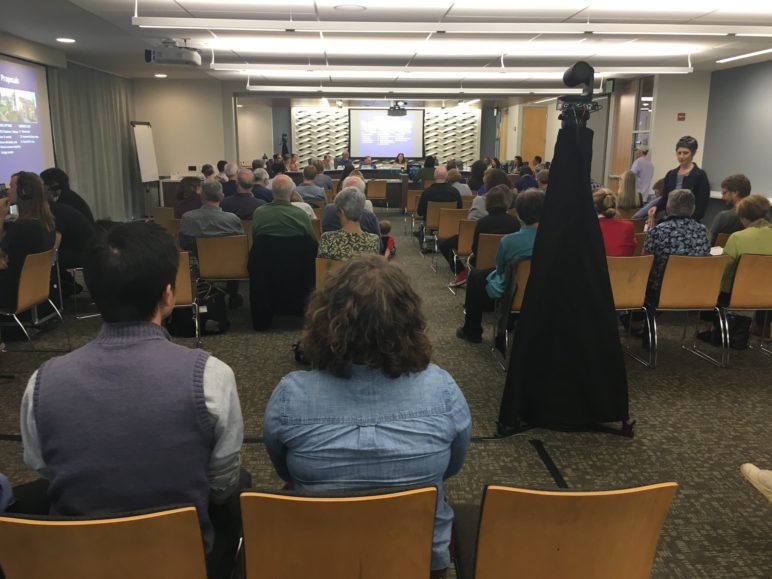Should pro-housing advocates focus on making bad cities less bad, or on making good cities better? Here in Cascadia, we’ve just seen some interesting evidence that relatively modest state laws actually do both.
That’s because state (and federal) laws that force anti-housing cities to welcome a bit more housing can also open up useful new debates in pro-housing cities. The trick is to override the universal bias toward the status quo.
The recent overhauls of low-density zoning in Oregon and Portland are prominent in a sweeping pro-housing article today from Vox writer Matthew Yglesias, whose last book happened to help inspire Sightline’s housing program.
Yglesias loops together many reasons housing shortages matter at the moment. Our overcrowded homes made the country “tinder for the spread of the virus.” California’s repeated failure to adequately reform its own zoning essentially aligns Santa Barbara Democrats with assault-rifle-wielding Republicans from St. Louis. There’s even a plausible argument that the 2008 financial crisis was triggered by an urban housing shortage that federal economists misinterpreted as a glut because they were paying more attention to the rate of exurban sprawl. The truth is that the housing shortages in parts of North America matter so much to everything else that they’ll always matter to the current moment. Addressing them would make almost every other problem easier to solve.
Yglesias argues that a way to address American housing shortages is with a lot more careful coalition-building like that led by my former colleague Madeline Kovacs, who laid the ground for these big state and local wins in Oregon by leading 1000 Friends of Oregon’s Portland for Everyone coalition and later Sightline’s own political organizing. He’s right.
Last summer, the Oregon state legislature took action to allow two-unit structures across almost the entire state and [four]-unit ones in its larger towns. This doesn’t “abolish the suburbs,” but it does ensure that a wider variety of house types are available in a wider range of communities.
And this summer, the city of Portland went even further…
The urbanist and illustrator Alfred Twu produced a graphic for Sightline that shows the breadth and scope of changes, including an easier path to build accessory dwelling units, relaxed parking rules, legalization of four-unit “cottage clusters,” and a structure for building small, six-unit apartment buildings if half the units are provided at deeply subsidized rates to poor families.
But as the country debates possible new federal incentives for zoning reform, something Yglesias calls for in his piece and in his latest book, I want to emphasize another relevant thing about Portland’s recent win. It’s a lesson I think housing reformers everywhere might find useful.
Last month’s “more radical” reform from the City of Portland—up to four homes on almost any lot, or up to six for projects with price controls—was successful largely because of the state’s “less radical” reform that passed last year.
That’s because Oregon’s state law didn’t just strike down duplex bans. It struck down the status quo.
When they don’t have a deadline, city leaders can keep dreaming of a perfect compromise

Portland planning commission hearing on infill, 2018. Photo by Michael Andersen, used with permission.
Until Oregon passed a law saying that all its larger cities and the Portland metro area had to allow at least two homes on any lot, Portland leaders had every incentive to hem, haw and dream of finding a solution that didn’t make lots of people angry.
“I’m in no rush,” Mayor Ted Wheeler said of the local zoning reform proposal in July 2018. While the city debate went on and on, more and more dilapidated homes were replaced with McMansions or remodeled into luxury oneplexes.
Twelve months later, Oregon’s state law finally ended that dynamic. Suddenly city leaders had a deadline—June 30, 2022, to be precise. On that day, duplexes would automatically become legal on any lot, and fourplexes in every area, unless the city could find a more nuanced local alternative.
To be clear, a majority of Portland’s city council had wanted to come to some sort of agreement on zoning reform since 2016. But when a loud minority of homeowners are constantly shouting at you that your policy will bring every imaginable evil upon the city, and when you have legitimate questions about how to minimize unintended consequences, it’s easy to keep kicking the can forever.
So state law forced a conversation. And in Portland’s local politics, it turned out that there was a lot of consensus not just that the number of homes should increase, but that many of the new market-rate homes built ought to have prices within reach of more Portlanders.
The path to that turned out to be fairly straightforward: allow up to four homes on any lot, not just two.
Oregon’s bipartisan state zoning reform even solved a problem within the Portland left
A similar dynamic played out within the city’s housing “left.” Two pro-tenant advocacy groups, Anti-Displacement PDX and Portland: Neighbors Welcome, generally agreed that duplexes, triplexes and fourplexes should be legal. But they spent years disagreeing about whether the fourth home in a fourplex should have a price restriction attached.
Oregon’s state law defused that. It required fourplexes to be legal by right in “all areas,” essentially taking that price restriction off the table. (This was in part because the state law had needed some rural Republican votes to overcome opposition from suburban Democrats, and in part because affordable housing developers had lobbied against any rules that would make it more complicated to build modest, low-cost homes for their future residents.)
But the Oregon law didn’t say a city couldn’t legalize two more units and put a price restriction on those. Essentially, the state law led both groups to start thinking bigger. Once they had, it became clear that they mostly agreed.
The result was something just about everyone on the left could cheer for: a previously unthinkable citywide legalization of below-market sixplexes.
The most powerful enemy of reformers is inertia

Portland overcame doubts to create a pedestrian plaza and bike lane outside Voodoo Doughnut after a three-day trial demonstrated how well it could work. State and federal zoning reform laws could have a similar effect by reducing the powerful lure of the status quo. Image by Greg Raisman, used under CC BY-NC-SA 2.0.
From 2013 to 2016 I reported for BikePortland.org, a blog about bike culture and infrastructure here in Portland. While working there, I learned two things over and over again.
The first was that in theory, most Portlanders are in favor of having a network of comfortable bike lanes. The second was that it is very politically difficult to add them to any specific street. This is because there’s only so much space between the curbs, and loss aversion—the human desire to value a bird in the hand more than two in the bush—makes people very uneasy about losing a passing lane or parking lane that’s on the street right now.
The biggest innovation that spread through Portland’s transportation movement in those years was a way to flip that script. (It was directly imported from New York City.) Instead of holding a year of meetings about whether to add bike lanes or pedestrian plazas to a particular street, the city started allowing temporary lanes and plazas to be installed as trials. This immediately advanced the debate from “why is change needed?” to “what sort of change would be best?” (Transportation Commissioner Chloe Eudaly has since applied the same concept to dedicated bus lanes.)
State-level zoning reform—and, potentially, federal zoning reform incentives—can work the same way. Not only could they force actively exclusionary cities to be less bad. They can also slice through some of the otherwise endless debates in cities with pro-housing politics but little progress to show for it.
That’s one way to get reforms that are, like Portland’s, revolutionarily good.











soren
“Anti-Displacement PDX and Portland: Neighbors Welcome, generally agreed that duplexes, triplexes and fourplexes should be legal. But they spent years disagreeing about whether the fourth home in a fourplex should have a price restriction attached.”
As you know, Michael, Anti-Displacement PDX organizers called for only allowing a duplex without price controls during the last stages of City Council RIP testimony. I strongly supported this even though I would greatly prefer that all new single and duplex homes be permanently banned in urban areas.
Michael Andersen
I was on the P:NW/ADPDX call with Pam and Nicole the morning before the first hearing and their official position, at least as I understood it, was “three plus one,” with the “one” having an affordability requirement. The P:NW folks made clear that P:NW’s position was four by right. But we both supported the sixplex option — P:NW was at that point proposing requiring those to be 100% below-market while ADPDX was proposing that only 50% of them be below-market.
ADPDX had a separate proposal to charge an “underbuilding” fee on oneplex projects that could have created more homes but didn’t. P:NW didn’t (and I think still doesn’t) disagree with that in principle, and it may yet come up again as a possibility when we start looking for ways to fund an Anti-Displacement Action Plan.